Tackling the school run: research study
A research study to provide the latest evidence on school transport choices.
Chapter 2 - Policy Context
Introduction
This chapter sets the scene to the study, providing an overview of school travel trends in Scotland as well as consideration of key policies.
School Travel Trends
Scotland
From a Scottish perspective, Scottish Transport Statistics No 34. reported that in the 2014 Scottish Household Survey, '51% of children in full-time education at school usually walked to school, 20% usually went by bus, 25% by car or van, 2% cycled. There was little difference between the sexes, but variations by age were more pronounced: 59% of primary school age pupils (those aged up to 11) usually walked to school compared with only 42% of those of secondary school age (those aged 12 and over); 29% of primary pupils travelled by car or van compared with only 18% of secondary pupils; and only 9% of primary pupils usually travelled by bus compared with 36% of those of secondary age.' The proportion of school pupils being driven to school has remained between 21% and 25% since 2003.
Table.2.1 illustrates mode split by geography. The data indicates more dependence on motorised transport, particularly the school bus, in less populated and more remote locations. In more urban areas of higher density and also in smaller self-contained towns, children are more likely to walk, scoot/skate or cycle to school with the geography more compact. The mode profile can be expected to be characteristic of the larger catchment areas for rural schools meaning walking and cycling is not an option with increased provision of school bus transport.
Table 2.1: Travel to School by Urban/Rural (Scottish Government, 2016)
| Geography | Walking | Car or Van | Bicycle | School Bus | Service Bus | Rail | Other |
|---|---|---|---|---|---|---|---|
| Large urban areas | 50.2% | 29.7% | 1.0% | 5.9% | 8.8% | 2.4% | 2.0% |
| Other urban | 53.3% | 25.5% | 1.4% | 12.5% | 4.4% | 0.3% | 2.6% |
| Small accessible towns and small remote towns | 63.2% | 15.5% | 1.6% | 14.0% | 4.6% | 0.5% | 0.7% |
| Accessible rural | 32.9% | 26.3% | 1.0% | 31.3% | 4.7% | 1.1% | 2.8% |
| Remote rural | 21.4% | 30.4% | 0.6% | 42.7% | 2.2% | 1.0% | 1.7% |
The Sustrans Hands Up Scotland Survey ( HUSS) is an annual survey undertaken since 2008 in the second week of September. Data is collected through a survey, asking pupils 'How do you normally travel to school?'', with the following response options: walk, cycle, scoot/skate, park and stride (driven part of the way by car and walk the rest), driven, bus, taxi and other. All local authorities in Scotland are invited to take part in the survey.
The most recent HUSS report for 2015, reported that over 2,060 schools took part in the survey across all 32 local authorities in Scotland. Out of this total, 2,045 were state schools (80.3% of all registered state schools in Scotland), with responses received from 474,200 state school pupils in Scotland (69.7% of all state school pupils enrolled in Scotland). The national level results for HUSS in 2015 are shown in Figure 2.1.
Figure 2.1: National Travel Modes - All School Pupils (exc. Nursery), (Sustrans, 2016)
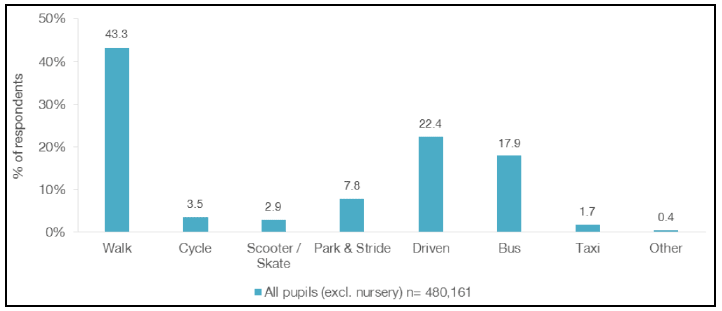
In summary, 49.7% of pupils surveyed in 2015 said that they normally travel to school in an active way (walking, cycling, using a scooter or skateboard):
- Walking was the most frequent mode of travel with 43.3% of pupils stating that they normally walk to school; and
- 3.5% of pupils said they normally travel to school by bicycle and 2.9% stated that they normally use a scooter or skateboard to travel to school.
A further 7.8% of pupils said that they normally park and stride to school. Furthermore, 42% of pupils surveyed in 2015 said that they normally travel to school using only a motorised mode of transport. The majority, were either driven to school (22.4%) or took the bus to school (17.9%). A further 1.7% travelled by taxi.
Figure 2.2 shows the 2015 HUSS results by local authority. This illustrates variations between local authority areas, characterised by more rural and remote authorities having a higher number of school journeys being undertaken by car and bus.
Figure 2.2: Travel modes at a Local Authority Level, 2015 (Sustrans, 2016)
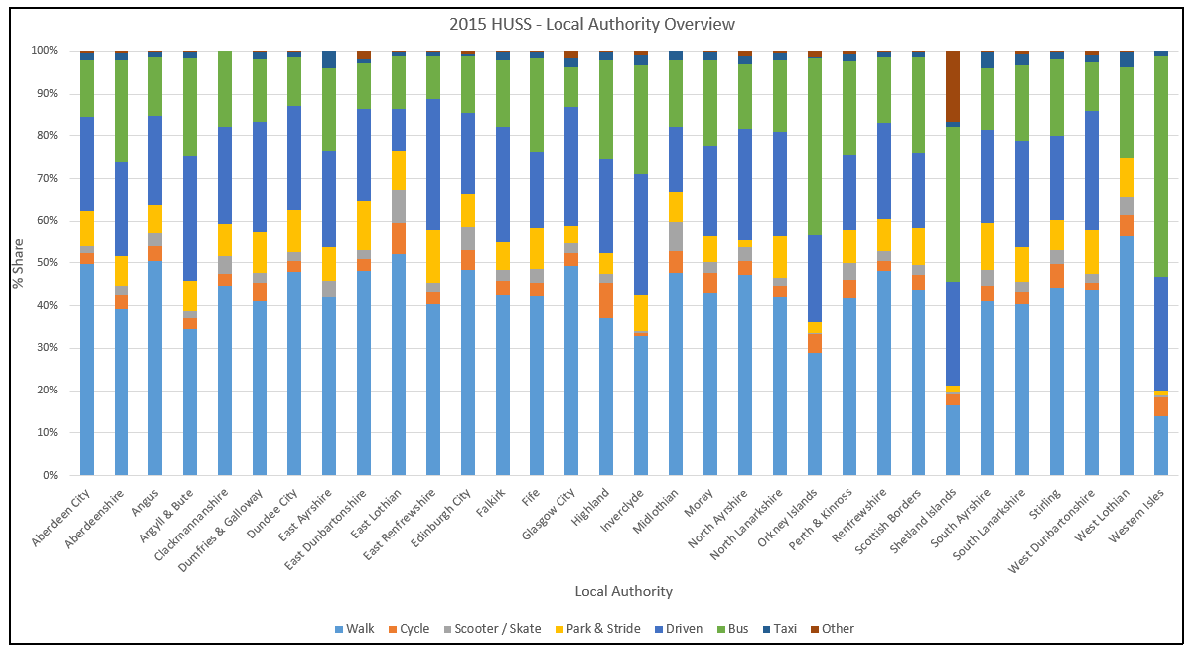
Figure 2.3 shows the 2015 HUSS results by primary and secondary school. In summary, primary school pupils are more likely to travel to school actively. There is a decrease in car use from primary to secondary school, with increased use of public transport among secondary school pupils reflecting larger school catchments and associated school bus provision.
Figure 2.3: Travel modes at a National Level: Primary and Secondary Pupil Responses, 2015 (Sustrans, 2016)
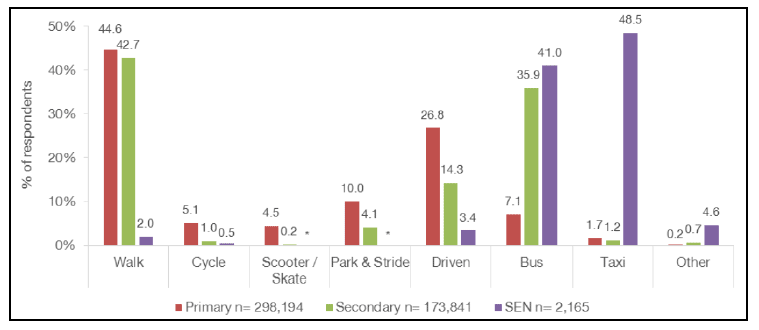
A comparison of independent and state school results showed that pupils at independent schools are less likely to travel to school in an active way than those in state schools (primary, secondary and special education needs ( SEN) as shown in Figure 2.4. A higher proportion of independent school pupils than state school pupils use motorised transport to travel to school, with the private car accounting for the highest proportion of all journeys compared to walking for state schools. This is expected to reflect the wider catchment of independent schools, with parents opting for their children to attend a fee-paying school and depending on location this can have a notable impact in terms of the length of the school journey compared to the location of the catchment state school.
Figure 2.4: Travel modes at a National Level: State and Independent Pupil Responses, 2015 (Sustrans, 2016)
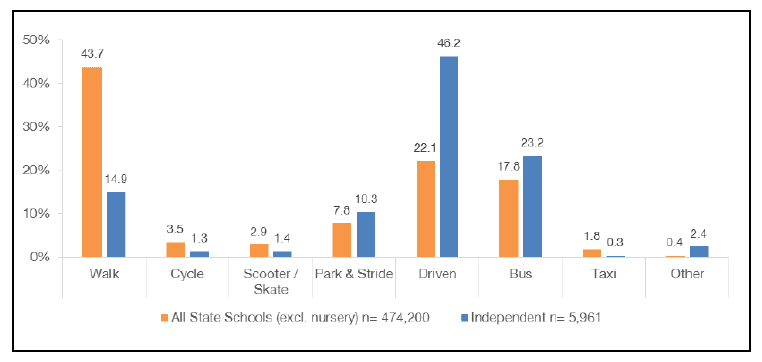
Table 2.2 summarises travel mode by year group. In summary, a smaller percentage of pupils in lower years (P1 - P4) walk to school compared to upper years (P5 - P7). In contrast, fewer older pupils are driven (all the way to school) with a larger difference in the number walking. At secondary school there is generally a similar profile between younger (S1 - S3) and older (S4 - S6) year groups with a small difference characterised by a higher percentage of older pupils being driven to school.
Table 2.2: National Travel Modes: By School Type and Year Group (Sustrans, 2016)
| School Type Year Group | Walk | Cycle | Scooter/Skate | Park & Stride | Driven | Bus | Taxi | Other | Total |
|---|---|---|---|---|---|---|---|---|---|
| Primary | |||||||||
| P1 - P4 | 42.0% | 4.8% | 4.9% | 9.7% | 29.9% | 6.8% | 1.7% | 0.2% | 159,106 |
| P5 - P7 | 47.8% | 5.6% | 4.0% | 10.9% | 22.5% | 7.5% | 1.6% | 0.1% | 106,838 |
| Secondary | |||||||||
| S1 - S3 | 43.4% | 1.1% | 0.2% | 4.7% | 13.1% | 35.6% | 1.4% | 0.6% | 79,963 |
| S4 - S6 | 41.8% | 0.8% | 0.3% | 4.0% | 16.4% | 35.0% | 1.1% | 0.7% | 58,181 |
| SEN | |||||||||
| P1 - P4 | * | * | 0.0% | 0.0% | * | 33.6% | 55.2% | 9.0% | 223 |
| P5 - P7 | * | 0.0% | 0.0% | 0.0% | 2.8% | 58.2% | 24.3% | 13.0% | 177 |
| S1 - S3 | * | * | 0.0% | 0.0% | * | 33.6% | 55.2% | 9.0% | 223 |
| S4 - S6 | 3.2% | 3.2% | 0.0% | 0.0% | 4.0% | 33.1% | 47.2% | 9.3% | 248 |
| Independent | |||||||||
| P1 - P4 | 17.2% | * | * | 7.2% | 34.3% | 35.7% | 0.6% | 4.5% | 1,276 |
| P5 - P7 | 15.0% | 1.4% | * | 14.1% | 45.1% | 21.6% | * | 1.4% | 1,267 |
| S1 - S3 | 17.2% | * | * | 7.2% | 34.3% | 35.7% | 0.6% | 4.5% | 1,276 |
| S4 - S6 | 20.5% | * | * | 6.2% | 32.5% | 35.6% | * | 4.8% | 1,256 |
Table 2.3 summarises mode share for the journey to school by year between 2008 and 2015. Active travel is the most frequently reported mode of travel to school in Scotland, at approximately 50%. At the individual mode level walking to school decreased slightly from a high of 48.3% to a low of 43.3% in 2008 and 2015 respectively. Cycling has increased from 2.8% to 3.5% over the same period. The percentage of pupils who scoot or skateboard has increased from 0.7% (2008) to 2.9% (2015).
Motorised travel has remained around 41% to 42% over the period between 2008 and 2015. Car use has fluctuated between a low of 21.4% (2013) and high of 23.3% (2009), with an overall increase from 22% in 2008 to 22.4% in 2015. Bus and taxi use have remained fairly consistent at approximately 18% and 2% respectively. The percentage of pupils travelling to school by park and stride has increased from 6.1% in 2008 to 7.8% in 2015.
Although survey design and methodology have remained consistent, survey sample size has increased considerably from over 390,000 pupil responses in 2008 to just over 480,000 in 2015. In addition, 2010 was the first year all local authorities participated in HUSS. In comparing data across years it is important to recognise the increase in sample size. Also, a number of variables may impact on travel behaviour from year to year ( e.g. weather conditions, school mergers) as well as policies and schemes introduced by central and local government or individual schools.
Table 2.3: National Travel Modes: All Schools (exc. Nursery) 2008 - 2015 (Sustrans, 2016)
| Year | Walk | Cycle | Scooter/Skate | Park & Stride | Driven | Bus | Taxi | Other | Total |
|---|---|---|---|---|---|---|---|---|---|
| 2008 | 48.3% | 2.8% | 0.7% | 6.1% | 22.0% | 18.2% | 1.4% | 0.5% | 396,377 |
| 2009 | 47.0% | 2.3% | 0.6% | 6.7% | 23.3% | 18.1% | 1.6% | 0.4% | 415,804 |
| 2010 | 45.8% | 2.8% | 0.7% | 7.4% | 22.9% | 18.2% | 1.6% | 0.5% | 439,401 |
| 2011 | 45.9% | 3.0% | 1.0% | 7.5% | 22.4% | 18.2% | 1.6% | 0.3% | 427,104 |
| 2012 | 45.1% | 2.9% | 1.6% | 7.8% | 22.2% | 18.2% | 1.7% | 0.5% | 457,488 |
| 2013 | 44.1% | 3.5% | 2.8% | 7.5% | 21.4% | 18.8% | 1.6% | 0.4% | 467,397 |
| 2014 | 44.2% | 3.4% | 2.8% | 7.8% | 21.9% | 17.7% | 1.6% | 0.5% | 487,147 |
| 2015 | 43.3% | 3.5% | 2.9% | 7.8% | 22.4% | 17.9% | 1.7% | 0.4% | 480,161 |
Scotland in Context
The results of the 2014 National Travel Survey in England reported that car and walking are the two most common modes of travel to primary school, each accounting for 46% of all trips as shown in Figure 2.5. Walking was the most common mode of travel to school for secondary children (aged 11 to 16 years), followed by local and private bus (29% of all trips) with car accounting for 23% of trips. These figures differ in some respects from Scotland, particularly with the car accounting for a notably higher proportion of trips made by both primary and secondary pupils. Walking levels amongst secondary pupils are also higher in Scotland.
For children aged 11 to 13 years of age, the two main reasons for mode choice are that it is convenient and that the school is too far away. Escort trips to school were found to be more likely to be made by women aged 30 to 49.
Figure 2.5: Travel to School in England (Department for Transport, 2014)
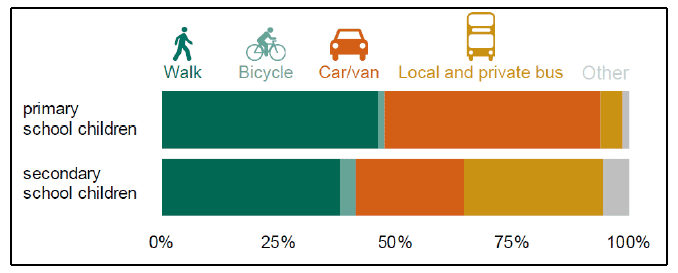
Policy
The promotion of active travel to school is an issue which cuts across transport, public health, environment, climate change and planning policy agendas. This section outlines key policy areas directly related to the school run.
Transport Policy
The National Transport Strategy ( NTS) sets the long-term vision for transport policy in Scotland. It was first published in 2006 and more recently refreshed in 2015 followed by an announcement in August 2016 that a full review will be undertaken. In terms of school travel, the NTS notes that:
"We need to tackle the congestion problems in many of our cities and towns, including those caused by the School Run which also lead to inactive lifestyles for our children and road accidents which cause deaths and injuries and contribute to problems of congestion and unreliable journey times."
The NTS is complemented by mode specific policies, including A Long Term Vision for Active Travel in Scotland 2030 (Transport Scotland, 2014) which contains the vision that:
"Scotland's communities are shaped around people, with walking or cycling the most popular choice for shorter everyday journeys. This helps people make healthy living choices and assists in delivering places that are happier, more inclusive and equal, and more prosperous. Travelling by foot or cycle, or with a personal mobility aid such as a mobility scooter, is a realistic option for all local journeys as individuals. People are confident to walk and cycle more often and they value and use their local transport networks (streets, roads and path networks), which offer safe, high quality, realistic and predictable journey options for active travel."
It contains the specific aspiration that "There will be a range of programmes available to support employers, schools and community groups to ensure that active travel can continue to develop."
The Cycling Action Plan for Scotland 2013 ( CAPS) (Transport Scotland, 2013) sets out clear ambitions for increasing the proportion of short journeys completed by walking or cycling, including trips to/from school. This is underpinned by the vision that by 2020, 10% of everyday journeys will be undertaken by bike. An 'everyday' journey includes travelling to school, college/university, work and personal business. CAPS also actions the preparation of an Active Travel Strategy by local authorities and this is also a recommendation of the Let's Get Scotland Walking: The National Walking Strategy (Scottish Government, 2014).
At the regional and local level, Regional Transport Strategies and Local Transport Strategies are also supportive of active and sustainable travel for the school journey and a joined up approach is advocated consistently.
As well as the transport aspect, other policy areas - education, health, environment and planning - are also of relevance in relation to school travel. Key policies are discussed here.
Education Policy
Curriculum for Excellence (CfE) is founded on the principles to achieve a coherent, more flexible and enriched curriculum for 3 to 18 year olds in Scotland and based around six levels - Early, First, Second, Third, Fourth and Senior. This new Curriculum approach has opened up opportunities to integrate different programmes into classroom learning, including initiatives with a transport theme and as well as wider topic areas of relevance such as health and well-being and the environment for example, with examples discussed in Chapters 4 and 7 of this report.
Getting It Right for Every Child ( GIRFEC) is "the national approach in Scotland to improving outcomes and supporting the well-being of our children and young people by offering the right help at the right time from the right people". The approach aims to support pupils and their parent(s) to work in partnership with the services that can provide assistance.
Well-being sits at the heart of the GIRFEC approach and reflects the need to tailor the support and help that children, young people and their parents are offered to support their well-being. There are eight indicators of well-being, with the following most pertinent from an active travel view point, point of view:
- Healthy - having the highest attainable standards of physical and mental health, access to suitable healthcare and support in learning to make healthy, safe choices;
- Achieving - being supported and guided in learning and in the development of skills, confidence and self-esteem, at home, in school and in the community;
- Active - having opportunities to take part in activities such as play, recreation and sport, which contribute to healthy growth and development, at home, in school and in the community; and
- Responsible - having opportunities and encouragement to play active and responsible roles at home, in school and in the community, and where necessary, having appropriate guidance and supervision, and being involved in decisions that affect them.
Environmental Policy
Reducing the number of car related school trips and associated congestion (particularly in the week-day morning peaks) would have positive impact in terms of contributing to the reduction in emissions of atmospheric pollutants which cause poor air quality and greenhouse gases that lead to global climate change.
The Climate Change (Scotland) Act 2009 sets out the statutory framework for greenhouse gas emissions reductions in Scotland. This establishes an interim 42% reduction target for 2020 and an 80% reduction target for 2050 underpinned by annual targets. The Government's Report on Proposals and Policies ( RPP) is published annually and sets out how Scotland can deliver its climate change targets as set by the Climate Change Act. With the transport sector accounting for approximately 25% of CO 2 emissions, more sustainable and greener travel choices for all trips, including the journey to school, have an important contribution to make towards achieving the targets set by the Climate Change Act.
Cleaner Air for Scotland - The Road to a Healthier Future ( CAFS), published by the Scottish Government in 2015, provides a national framework which outlines how the Government proposes to achieve further reductions in air pollution. CAFS recognises that the health impact of air pollution can have a negative impact in terms of the loss of school time and makes note of the Pilot being undertaken by the City of Edinburgh Council to restrict traffic around several schools where road safety issues have been raised as a concern. The intention of the Pilot is to reduce the number of children dropped-off by car and to encourage increased levels of walking and cycling to and from school. Further information about the Pilot is provided in Chapter 4.
Health Policy
There is strong evidence that being physically active is beneficial for the health of body and mind. For children, high activity levels provide both immediate and longer-term benefits, for example by improving the health of the heart, muscles, bones, and immune system, and reducing the risk of chronic conditions such as obesity. Being active can also help to improve mental health and wellbeing by reducing depression and anxiety in children, boosting self-esteem and sleep quality, and laying the groundwork for academic attainment. The forthcoming ten-year mental health strategy will include a focus on early intervention and the mental health of children and adolescents.
Furthermore, the obesity strategy for Scotland, Preventing Overweight and Obesity in Scotland (Scottish Government, 2010) highlights increasing opportunities for uptake of physical activity as a core action in obesity prevention. A message that will be continued as the policy is reviewed in 2017.
The UK Chief Medical Officer's report Start Active, Stay Active recommended active travel as one way of making up the recommended 60 minutes of moderate to vigorous intensity physical activity daily for children, as well as outlining the links between physical activity and health.
The 2014 Glasgow Commonwealth Games raised the profile of sport and physical activity in Scotland. Building on this, the Scottish Government committed to increasing rates of physical activity and through the Active Scotland Outcomes Framework and Physical Activity Implementation Plan, Scotland is leading the way in its strategic response to the challenge of increasing physical activity and reducing sedentary behaviour.
The Active Scotland Outcomes Framework sets out Scotland's ambitions for a more active Scotland, including improving our active infrastructure. Success will rely on the collective efforts of communities, individuals and a wide range of partners in areas such as health and social care, education, environment, transport, communities and sport and active recreation. The outcomes will be achieved through the delivery of A More Active Scotland, the Physical Activity Implementation Plan, which adapts key elements of the 2010 gold standard advocacy tool, the Toronto Charter for Physical Activity (Bull et al., 2010), to Scotland.
One of the key delivery themes concerns education settings and commits that 'all learning places in Scotland will promote increased physical activity.' There is also recognition that active travel has a positive contribution to make in terms of physical activity:
"Promoting active travel on the school journey can make a positive contribution and complement policy and related initiatives to promote healthy lifestyles and physical activity." A More Active Scotland: Building a Legacy from the Commonwealth Games (2014)
Planning Policy
From a planning perspective, new schools in Scotland are subject to national and local authority planning policy and procedures. Scottish Planning Policy ( SPP) and National Planning Framework ( NPF) advocate sustainable and well connected development with the Scottish Government's Designing Streets (2010) policy statement setting out guidance that puts 'place and people before the movement of motor vehicles'.
At the school level, the Scottish Government/Coalition of Scottish Local Authorities ( COSLA) joint strategy for school buildings, Building Better Schools: Investing in Scotland's Future (2009) notes a need to:
"…focus attention on all aspects of sustainability and environmental efficiency…[and]… options for sustainable travel' and' improve the way we think about a school's fit with its surroundings and relationship to the community."
"Looking outwards, the extensive network of linkages, movements and activity generated by each school is another important aspect of its dynamics. The daily pattern of home to school travel on the part of pupils, staff and community users of school facilities is the most visible manifestation of this and reaches into every community in the land."
In addition, Creating Places: A Policy Statement on Architecture and Place for Scotland (Scottish Government, 2013) promotes well connected places with priority for pedestrians and the intention to build a sustainability 'Gold', 'Silver and 'Bronze' labelling for new schools (similar to new homes).
The recent Empowering Planning to Deliver Great Places - Independent Review of the Scottish Planning System includes a number of observations and recommendations of relevance to this study. Notable points include:
- Future school building programmes should address the need for new schools in housing growth areas;
- There appears to be little alignment of corporate responsibility to deliver new schools. More consistency in approaches to catchment planning, developing specifications and costing new schools is clearly required. There are suggestions that a 'blended' approach involving both public and private sector investment is required to ensure new schools are funded; and
- A high level of certainty is required to justify the building of new primary and in particular secondary schools to meet future needs arising from development. It is widely accepted that development delivery is being hindered by reliance on the private sector to finance new schools.
Summary
School travel trends indicate that active travel accounts for the largest proportion of the school journey in Scotland, but varies between primary and secondary years as well as state and independent schools. This is reflective, in part, of the school catchment area alongside wider factors which are discussed further in later chapters.
From a policy perspective, the impact of the school run is cross-cutting. It has direct impact in terms of transport and associated congestion and national targets to increase travel by more sustainable and active modes. The journey to school is also influenced by wider policy, particularly in terms of planning and also impacts directly on other policy areas including health and the environment.
Contact
Email: Veronica Smith
There is a problem
Thanks for your feedback